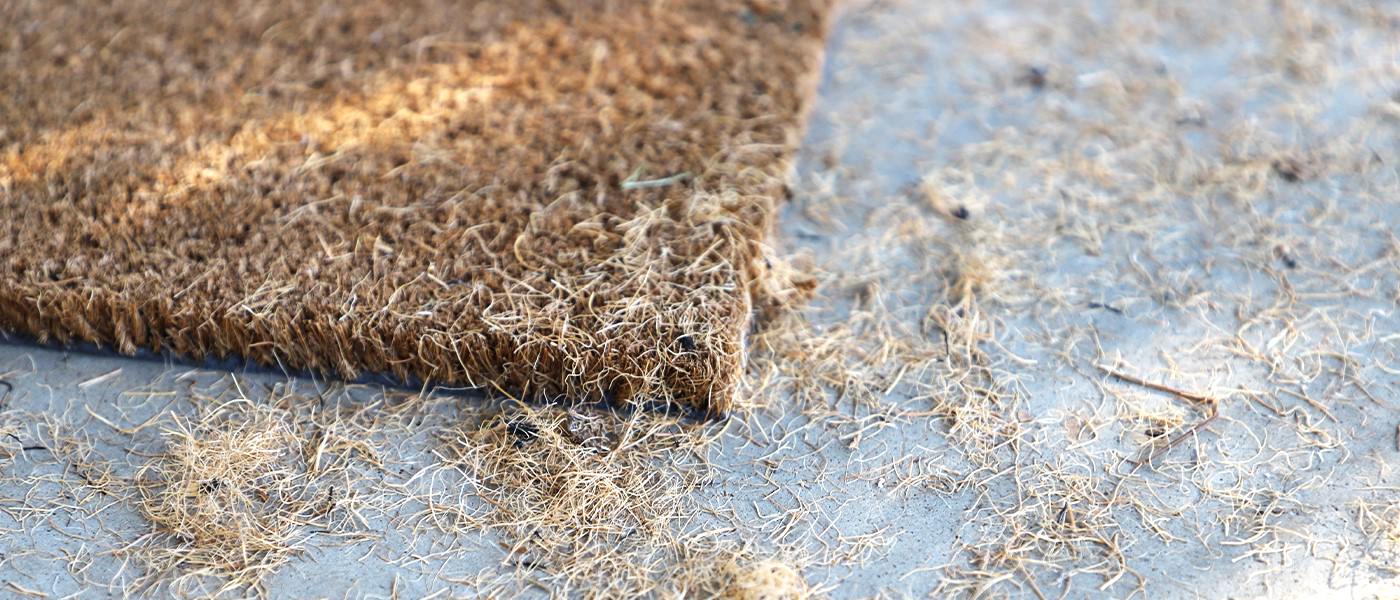Admit it. Your mat stinks. It literally stinks. Such is the plight of the popular but poor choice of a coco mat. How bad are coco mats? Let us count the ways...
They Shed : Coco mats shed like a Christmas tree in January! If the purpose of a doormat is to help keep you floors cleaner, then a mat that sheds all over your porch and tracks into your house sort of defeats the purpose, doesn't it?

They Smell : There's no denying it. Coco mats stink, but it's not entirely their fault. They're made from fibers in coconut husks - thus the name - and those fibers are HIGHLY absorbent. While absorbent may seem like a good quality for a mat, it's not if the fibers don't dissipate the moisture. Coco fibers have an extremely high water-holding capacity. Meaning they absorb water and hold onto it rather than dissipate it. The prolonged moisture is what causes the foul odors they typically emit after a few weeks of use.
They Are NOT Eco-Friendly : For years, manufacturers of coco mats have touted the eco-friendliness and sustainability of coco mats because those coco fibers come from coconut husks and are a waste product from the coconut industry. However, the use of waste does NOT an eco-friendly product make. Coco fibers require a significant amount of water to process, and the process creates a tremendous amount of polluted waste water. Most coco is processed in countries like Sri Lanka, Philippines, Vietnam and Indonesia where unpolluted water is in short supply. Furthermore, the processing creates extremely dusty working conditions known to induce nasobronchial allergies and abnormalities with pulmonary function. Working conditions like this are not legal in North America or Europe. Lastly, once the fibers are processed and mats are made, they must be shipped halfway across the world which even further expands their already large environmental footprint.
So do yourself and the environment a favor - say no-no to coco. There are better performing, more eco-friendly mat options available to you.
If you're looking for an outdoor mat that can handle the rigors of an uncovered environment, try our Needle & Tread doormat. It's made in America with post-consumer and post-industrial recycled materials, and it's anti-microbial to resist those pesky odor-causing bacteria. It’s also fade resistant and the unique “peak and valley” design helps keep your floors clean. The peaks scrape the dirt and moisture from your shoes into the valleys that keep it below foot-level so the next person doesn’t pick it up and track it in on their shoes.
If you're looking for something a little more decorative for a covered doorway or just inside your door, try our Neighburly doormat. Its look is reminiscent of a coco mat, but it's made with recycled materials and doesn't shed or smell.
Answers to Frequently Asked Questions (FAQ) about Coco or Coir Mats:
What is a coir mat?
Coir is the fibrous material between the hard shell of a coconut and the outer coat. It's used to make what are commonly referred to as coco mats or coir mats. Coir/coco mats are so prevalent their signature wheat-brown color has been dubbed "coir" and is used to describe that color even when not referring to doormats.
Is coir good for doormats?
While coir is probably the most widely used material for doormats, it's less than ideal for a number of reasons. It sheds often causing more tracking in your home than it prevents. If coir mats are in an uncovered area and subject to rain, they typically stay wet for long periods of time which can cause odors. And despite being made with a renewable material, the process to manufacture coir mats isn't particularly eco-friendly, nor is its carbon footprint since coir mats are typically transported to the U.S. from the south Pacific.
Are coir mats for outside?
Coir mats are designed for use outside. They tend to shed very badly so you would never want to use one inside your doorway.
Can coco or coir mats get wet?
Coir mats can get wet, but they do not dry quickly so they can easily become water-logged which can lead to rather unpleasant odors and bacteria and mold and mildew growth.
How do you clean coir mats?
It's very difficult to clean a coir mat. Your best bet would be to spray it off with a hose, but depending on the quality of your coir mat, you may lose many of the bristles during that process.

